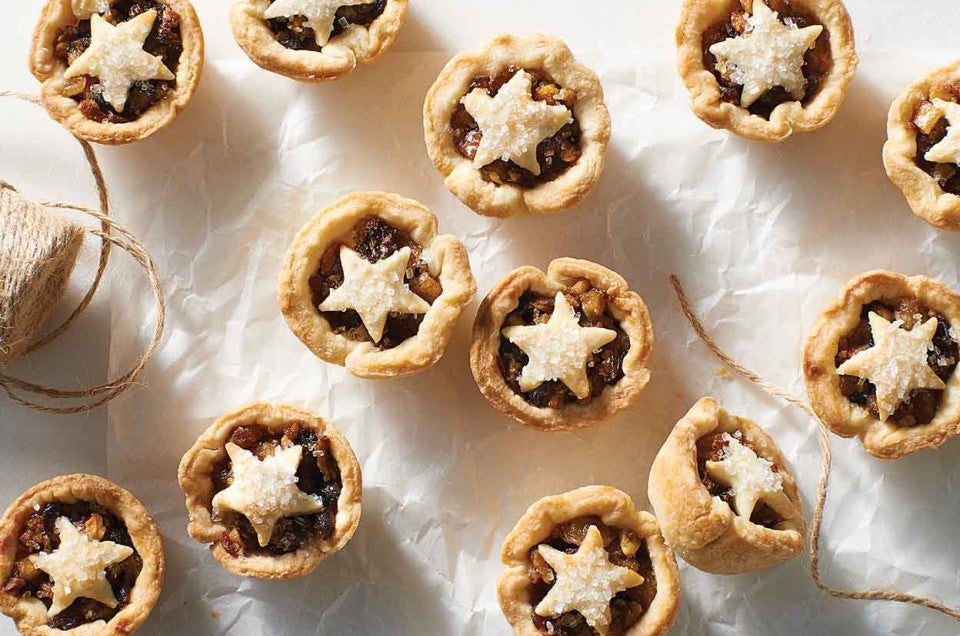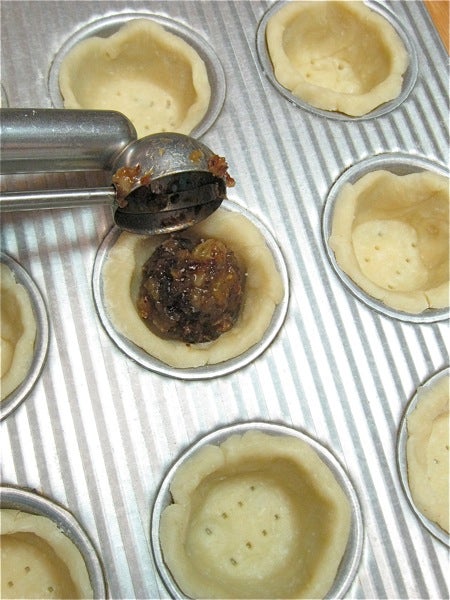


What's the quintessential English Christmas dessert?
Ah, so many to choose from... Plum pudding? Trifle?
Sugarplums, dancing in your head and right onto the dessert buffet?
In doing research for our new Holiday Baking Traditions recipe series, I looked everywhere online for English Christmas desserts. And discovered a treasure trove of recipes for “pudding” – plum, or Christmas, apparently much the same thing.
This glistening, dark-brown, bowl-shaped confection features dried fruits, including prunes and raisins; the ubiquitous but often unwelcome mixed peel; and, the deal-breaker for most of us Americans: suet.
Mention pudding made with suet – beef fat – and the average American will give you the wrinkled nose, the furrowed brow, the “beef fat belongs on my barbecue, not in my dessert” look.
But think about it; if your mom or grandma made pie crust (or fried doughnuts) using lard (pig fat), there's not a whole lot of difference. Cornbread baked in bacon grease is another tasty way we've traditionally used animal fat in baking.
So why the resistance to suet?
Maybe it's just the unfamiliarity factor. Who knows, Brits might have the same reaction to lard.
“Pig fat? In my treacle tart? EWWWWWWWW." (Or the equivalent British exclamation of disgust.)
At any rate, I decided to bypass plum pudding in favor of what appears to be the #2 English Christmas dessert: brandied mince tarts.
“Mincemeat? You mean that icky meat and fruit stuff that people put in pie and then it's the last pie left on the table at Thanksgiving, and no one's touched it?”
No, not THAT mincemeat. British Christmas mince is FRUIT mince. Made from raisins and currants, apples and nuts, sweetened with brown sugar and taken over the top with a generous splash of brandy, fruit mince is nicely spicy, full-flavored, and the perfect filling for tiny, two-bite tarts.
The following recipe, with a bit of Americanizing, comes from Sue Dyer, an Australian with British roots. Sue and I have never met; and we probably never will. But we've been email pals for awhile. So I asked Sue what she thought about Christmas pudding. Here's what she said:
“My mum used to make suet pudding when I was a kid and I wouldn't eat it.”
She then went on to describe her Christmas plans:
“Baking will be mince pies (using my own fruit mince recipe – I'll send you a copy if you like), shortbread, chocolate truffles, and gingerbread men. I put them on plates that I don't want back and dress them up with tinsel, etc. It's interesting how, in these days of rampant consumerism, people's eyes light up when you give them something home-baked... ”
I told Sue yes, I'd love the mince recipe, and she sent it to me with this note:
“You need a good, rich shortcrust pastry, and you can make them with or without lids. I make them like tarts with a piece of star shaped pastry on top. More fruit (best bit), less pastry. Use good French brandy for the best flavour. Scrumptious.”
Scrumptious indeed.
Sue added, “I've only used this recipe for mince pie at Christmas. I guess you could heat it and use it as a sauce with ice cream. I find it hard not to just eat spoonfuls of it when I'm making it. And of course it has to be tested when it's maturing in the fridge. Frequently.”
She's right. I made the fruit mince in August, made two batches of tarts (yes, it makes quite a lot), and am still, 3 months later, sampling the remaining mince in the fridge.
Frequently.
Want to try something new this year? And change your mind about mincemeat in the process?
Brandied Mince Tarts, here we come!
First, some preliminary tasks. Grate the rind from 1 small orange. I made the mistake of using a large orange the first time I made this; the mince was unpleasantly citrus-y.
Grate the rind from 1 small-to-medium lemon. A Microplane grater-zester works extremely well – and you never worry about grating your knuckles.
Next, ready your fruit. We'll be using two kinds of raisins, plus Zante currants.
Golden raisins, Thompson raisins, Flame raisins, sultanas, currants... what's the difference?
Raisins are sun-dried grapes, and different types of raisins come from different grape varieties. Two of the most popular seedless raisins in the U.S. are Thompson (above, left); and Flame, typically larger and moister than Thompson. Golden raisins (a.k.a. sultanas; above, center) are Thompson raisins that have been chemically treated, then flame-dried to attain their light-gold color.
Tiny Zante currants (above, right; usually shortened to just “currants”) come from Black Corinth grapes.
Mixed candied peel is orange and lemon peel, and citron.
Ah, the mysterious and much-maligned citron! What is it?
Citron is a Mediterranean fruit. Looking rather like a very large (up to 10 pounds), misshapen lime, it's prized not for its juice, but rather for its thick rind, which is diced or sliced, then pickled, candied, brewed into tea, or turned into jam.
Finally – let's begin. Put the following into the work bowl of a food processor:
1 cup (142g) raisins, Thompson or Flame
1 cup (142g) golden raisins
1 cup (128g) Zante currants
2 medium Granny Smith apples, peeled, cored, and sliced or coarsely chopped
1/4 cup (35g) mixed candied peel
grated rind of 1 small orange
grated rind of 1 small-to-medium lemon
Process until finely minced, but not puréed.
What if you don't have a food processor? Then you'll be doing a LOT of fine chopping by hand – or in small batches in a blender.
Add the following:
3/4 cup (159g) dark brown sugar
2 teaspoons English mixed spice, or a combination of 3/4 teaspoon cinnamon, and 1/2 teaspoon each nutmeg and allspice
1/8 teaspoon salt
Process until JUST combined.
Add 2/3 cup (71g) slivered almonds. Process briefly, just to break up the almonds.
Transfer the mixture to a bowl. Add a scant 1/2 cup (67g) golden raisins, and 1/3 cup (43g) currants.
Add 2 1/2 tablespoons (35g) melted butter.
Next, the brandy part of these brandied tarts. Choose a decent bottle of brandy, French preferred. It doesn't have to be expensive; the bottle above cost just under $10.
Add 1/4 cup (57g) brandy.
Stir to combine thoroughly.
Store airtight in the refrigerator, until ready to use; stir it occasionally, to redistribute the juice. Mince will keep for several months in the refrigerator, tightly covered. Or freeze it, for long-term storage.
Next, we'll make the tart dough. This is most easily done with the help of a food processor, though it's also simple to make it by hand.
Put the following in the bowl of your food processor:
2 cups (241g) King Arthur Unbleached All-Purpose Flour or Perfect Pastry Blend
heaping 1/2 teaspoon salt*
8 tablespoons (113g) butter, cut into pats
*Reduce the salt to a level 1/2 teaspoon if you use salted butter.
Process until the mixture is evenly crumbly.
Unlike a typical American pie crust, this “short crust” shouldn't have any large pieces of butter remaining; the mixture should look like breadcrumbs.
Drizzle in 2 tablespoons ice water.
Process; the dough should start coming together. Add an additional tablespoon of water...
...and process again. It should have come together nicely.
Remove the dough from the processor, and squeeze it together.
Divide the dough in half, and shape each piece into a flattened ball, or wheel.
Roll the edges to smooth them out; they should look like big hockey pucks. Wrap in plastic, and refrigerate for 30 minutes, or overnight.
When you're ready to prepare the tarts, remove the dough from the refrigerator. If it's been chilling for longer than 30 minutes, let it warm for 15 minutes or so, until it's “rollable.”
Start preheating your oven to 400°F.
Work with one piece of dough at a time. Place it on a well-floured work surface; our silicone rolling mat works well here.
Roll the dough into a 10" circle, about 1/8” thick.
Select your pan(s). For mini tarts, a mini muffin pan works well. For slightly larger tarts, use a standard muffin pan.
I've chosen to make mini tarts, using a mini muffin pan. Now, how big should the dough circles be for a mini muffin pan?
Measure the bottom diameter of one of the muffin cups; that's your starting point. For a mini muffin pan, add 1". For a standard muffin pan, add 1 1/2" (so that the dough will come 3/4" up the sides of the cup).
Example: If one of the cups in your mini muffin pan measures 1 1/4" across the bottom, you'll want to cut 2 1/4" rounds of dough.
Cut rounds of dough - 24 for a mini muffin pan, 12 for a standard muffin pan. A 2 1/4" biscuit cutter works well for the mini tarts. Save any scraps for the stars that'll go on top. (If you're making small (rather than mini) tarts, a 3 3/4" English muffin ring is close enough.)
Roll out the second piece of dough, and cut rounds. Again, save the scraps.
Nestle the dough circles gently into the muffin cups. Don't stretch them.
Wherever the dough folds, snip through the fold...
...and lap one side over the other, pressing to seal.
Prick the bottom of each tart several times with a fork, to prevent them puffing as they bake.

Spoon about 2 teaspoons fruit mince atop each of the mini tart crusts; a level teaspoon cookie scoop works well.
If you're using a standard muffin pan, spoon about 4 generous teaspoons filling into the tarts; a slightly heaped tablespoon cookie scoop works well.
Cut stars from the dough scraps: 1 1/4" stars for the mini tarts, 2" stars for the small tarts.
Now, what to do with any leftover dough? Cut more stars...
...and sprinkle stars and scraps with cinnamon-sugar. Bake in a 400°F oven until lightly browned and crisp. Yummy!
OK, back to our original stars.
Spritz the stars with water, and center one star atop each tart.
Sprinkle heavily with Baker's Special sugar or castor (superfine) sugar, if desired.
Enough fussing! These are ready for the oven.
Bake the mini tarts for about 20 to 22 minutes, until they're golden brown. The larger tarts should bake for about 28 to 30 minutes, again until they're golden brown.
What's going on with the picture? I was experimenting with baking the stars separately. Not necessary.
Also, I was using a 20-cup mini muffin pan, instead of a 24-cup; since this recipe makes 2 dozen mini tarts, it's best to choose a 24-cup mini-muffin pan.
Remove the tarts from the oven.
Serve warm, with brandy butter or heavy cream; or at room temperature.
Here they are: 1 3/4” mini tarts, and 2 3/4” small tarts.
Tender, buttery, crumbly crust; sweet, aromatic fruit filling. And you thought you didn't like mince(meat)!
Read, rate, and review (please) our recipe for Christmas Brandied Mince Tarts.